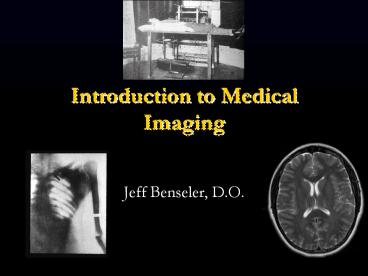Introduction to Medical Imaging - PowerPoint PPT Presentation
1 / 28
Title:
Introduction to Medical Imaging
Description:
Introduction to Medical Imaging Jeff Benseler, D.O. Medical Imaging (Radiology) Nearly all medical disciplines utilize medical imaging As you move from block to block ... – PowerPoint PPT presentation
Number of Views:218
Avg rating:3.0/5.0
Title: Introduction to Medical Imaging
1
Introduction to Medical Imaging
- Jeff Benseler, D.O.
2
Objectives
- Medical Imaging What to expect in your first 2
years at OUHCOM - Overview How do x-rays create an image of
internal body structures? - What are the advantages of CT, MRI and
Ultrasound?
3
Medical Imaging (Radiology)
- Nearly all medical disciplines utilize medical
imaging - As you move from block to block we will learn
- How each modality works to create an image of
internal body structures - Selecting the best imaging tests for a given
clinical presentation - Develop a stepwise repeatable pattern of
evaluating medical images
4
Method for learning medical image interpretation
- Most blocks will contain recorded presentations
- These recordings last approximately 10 to 30
minutes each - Most blocks will have 2 to 4 recordings to view
before the live class - The recordings can be viewed and reviewed as
needed anytime 24/7 - In class, we will learn by interpreting unknown
cases
5
Questions about medical imaging
- Please feel free to contact me with questions
- My preferred contact method is email
- benseler_at_ohio.edu
6
Objective 2
What are x-rays?
- No mass
- No charge
- Energy
X-rays are a type of electromagnetic energy
7
How do x-rays passing through the body create an
image?
- X-rays that pass through the body render the
image dark (black) - X-rays that are totally blocked render the image
light (white) - Air low atomic x-rays get through image
is dark (black) - Metal high atomic x-rays blocked image is
light (white)
8
5 Basic Radiographic Densities
1.
- Air
- Fat
- Soft tissue/fluid
- Mineral
- Metal
4.
5.
2.
3.
Name these radiographic densities.
9
Optimal environment for visual perception
- Dedicated source of light (5 to 9 mega pixel
monitors) - Darkened environment (like a movie theater)
- Limit distraction
10
X-ray viewing station
11
Can you recognize shapes and density?
12
Find the pathology What clues do you have?
13
Medical Imaging Interpretation3 basic steps
- First learn how each modality creates an image of
internal body structures - Next, be able to accurately label normal anatomy
(body structures) - Then, search for structures that dont belong and
for body structures that are abnormal in size,
shape, position and/or density
14
History 11 year old twisting injury of the foot
15
(No Transcript)
16
Naming the parts of a long bone
Distal
3.
2.
1.
Proximal
Word bank epiphysis, metaphysis, diaphysis,
cortex, medullary cavity
17
Review What are the 5 basic radiographic
densities from black to bright white?
- Air
- Fat
- Soft tissue/fluid
- Bone/mineral
- Metal
18
Summary for objective 2 How do x-rays create an
image of internal body structures?
- X-rays pass through the body to varying degrees
- Higher atomic number structures block x-rays
better, example bone - Lower atomic number structures allow x-rays to
pass through, example air in the lungs
19
Objective 3Advantages of CT, MRI and Ultrasound
- These modalities are cross sectional imaging
- Cross sections are like slices
- X-ray studies are a 2 dimensional representation
of 3 dimensional structures can result in
undesirable overlapping densities and artifacts
20
CT
- Advantages
- Eliminates overlapping densities
- Excellent resolution
- Excellent for detecting intracranial bleeding
- Excellent in the neck, chest and abdomen
- Excellent for evaluating fractures
- Disadvantages
- More expensive than x-ray and ultrasound
- Much more radiation
- Dense bone (petrous ridge for example) and metal
cause severe artifacts
21
air
CT scan of the abdomen
X-rays used
skin
What density is this?
22
(No Transcript)
23
MRI
- Advantages
- No overlapping artifact
- Excellent resolution
- Very good at detecting fluid
- Excellent for imaging the brain, spine and joints
- No radiation
- Multiple imaging tests within the same study (T1,
T2, IR, GE)
- Disadvantages
- Very expensive
- Patients cannot have a pacemaker or ferromagnetic
material - Slower to acquire images
- (approximately 45 minutes)
24
(No Transcript)
25
Ultrasound
- Advantages
- No radiation
- Portable
- Instantaneous (real time)
- Excellent for cysts and fluid
- Doppler ultrasound is excellent to assess blood
flow - Excellent for newborn brain, thyroid, gall
bladder, female pelvis, scrotum, pregnancy
- Disadvantages
- Does not work well in large or obese patients
- Resolution less than CT and MRI
- Air or bowel gas prevents visualization of
structures
26
Ultrasound of the gall bladder showing a gall
stone
27
X-rays, CT, MRI and ultrasound help us see into
the body
- Internal body structures are composed of varied
material (fat, muscle, bone, gland) or contain
air, water or minerals that show up differently
on each type of imaging test. - Each modality has its own advantages allowing us
the choose the best one for each medical
circumstance.
28
What an excellent medical student at your level
can do
- Be able to describe how x-rays can create an
image of internal body structures - Recognize and label the 5 basic densities on an
x-ray - Be familiar with the advantages for CT, for MRI
and for ultrasound

